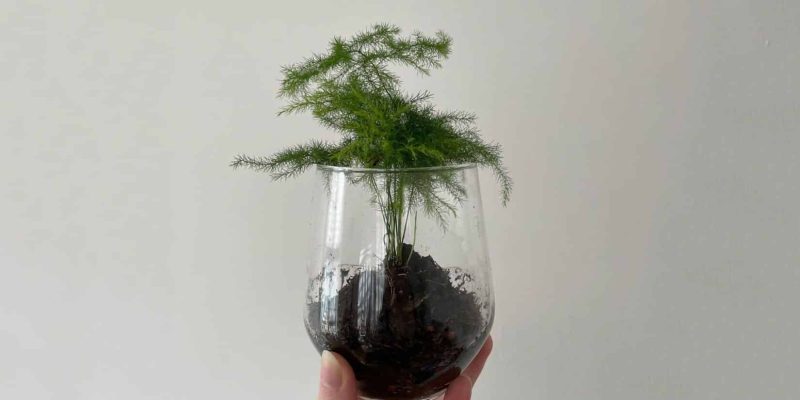Have you ever wished you could grow a lush green garden inside your home? No, we’re not talking about turning your living room into a jungle, but we do have a delightful solution for you that requires minimal effort — the asparagus fern!
This frondy houseplant is not a true fern, but like ferns, it offers dreamy, feathery foliage that will transport you to a serene, enchanted woodland with just one glance. A particularly happy asparagus fern plant will produce tiny white flowers or red berries, but this is a rare treat.
We’re excited to share everything you need to know about asparagus fern care. From its intriguing background to helpful tips, you’ll soon become an asparagus fern aficionado. So sit back, relax, and let’s embark on this fern-tastic journey together.
Table of Contents
Asparagus Fern Plant Care Guide
History, habitat, and characteristics

Asparagus fern (Asparagus densiflorus) is a delightful houseplant with a rich history and charming botanical characteristics. Contrary to what the name suggests, asparagus ferns aren’t actually ferns, but more closely related to the lily family. They’ve got slender, arching stems, feathery fronds, small flowers, and soft, furry foliage.
Its native habitat is South Africa, but the versatile asparagus fern is quite the world traveler. It’s adapted to a wide range of environments, from coastal dunes to rocky outcrops and dense forests. A top choice for indoor cultivation, it doesn’t mind different environmental conditions and is a breeze to care for — no green thumb required!
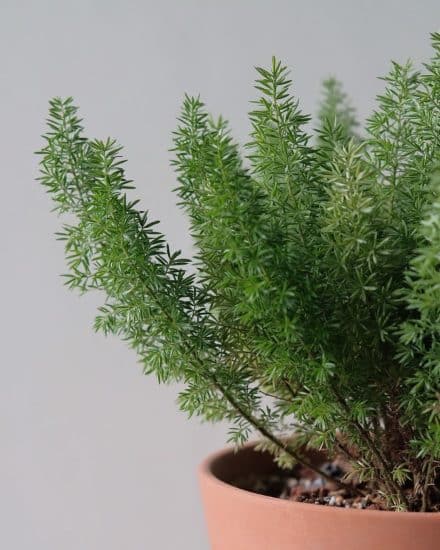
There’s a bit of a dark side to our verdant friend, though. The hardy nature and speedy growth of the foxtail fern have earned it the title of “invasive species” in parts of the United States, Australia, and New Zealand. It can crowd out native plants and disrupt ecosystems, but don’t worry — it’s still a fantastic houseplant as long as it’s grown responsibly indoors.
Fun fact: Our friendly Asparagus densiflorus got its name because its foliage resembles the leaves of the vegetable asparagus. They’re more than just lookalikes, though – they’re two different species in the same botanical family, Asparagaceae!
Varieties
There are at least half a dozen varieties of the asparagus fern species. We’ll dig into a few of our favorites.
(Note that Asparagus densiflorus is often confused with Asparagus setaceus or Asparagus plumosus, also known as the lace fern. You’ll also find Asparagus falcatus, with its spiky, sharp spines, is sometimes mislabeled).
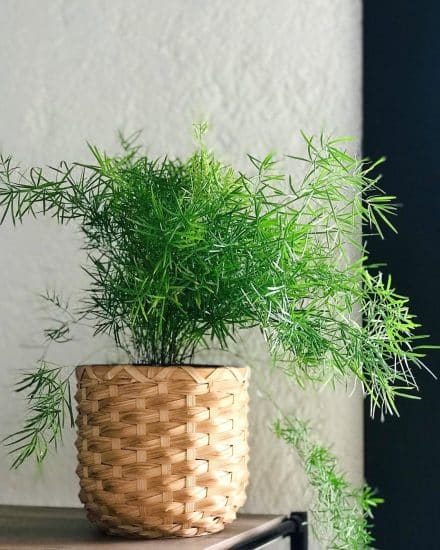
Asparagus densiflorus ‘Sprengeri’ features graceful, arching fronds adorned with small, needle-like leaves. The delicate, bright green foliage is airy and feathery, giving it a light and lively appearance. Its long, cascading branches make it an excellent choice for a hanging basket or as a decorative accent in mixed containers. During its blooming season, you can expect tiny white flowers, which eventually give way to red berries that provide a pleasant contrast to its leaves.
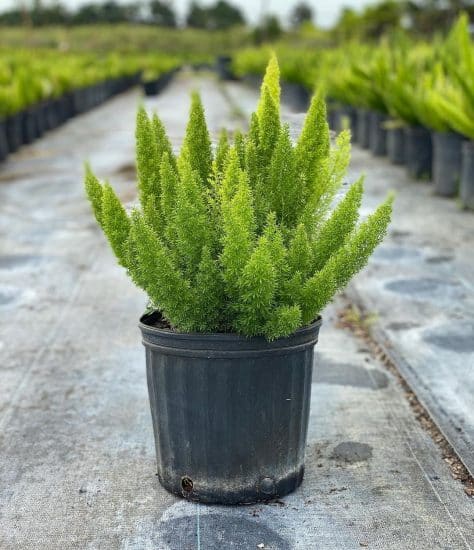
Asparagus densiflorus ‘Myers,’ commonly known as Myers asparagus fern or Foxtail fern, is distinguished by its bushy, upright fronds filled with tightly-packed, needle-like leaves. The vibrant green stems resemble bushy foxtails, providing a rich, textured visual that sets it apart from other asparagus fern varieties. While it also produces small white flowers and red berries, its lush foxtail-like stems are the true standout feature of this species.
Light

Bright, indirect light will imitate the dappled shade of a forest canopy and keep your asparagus fern pretty happy. In fact, they can handle various light conditions, but be cautious not to expose them to harsh, direct sun.
If you see the foliage of mature plants turning yellow, it’s a possible sign that they aren’t getting enough bright light. On the other hand, brown leaves indicate too much sun.
Our lighting tips:
- Position your asparagus fern near a window that lets in plenty of bright, indirect light for the best growth.
- Keep asparagus fern out of direct sun.
- Give your plant a spin every few weeks to ensure it grows evenly and receives balanced light exposure.
Water
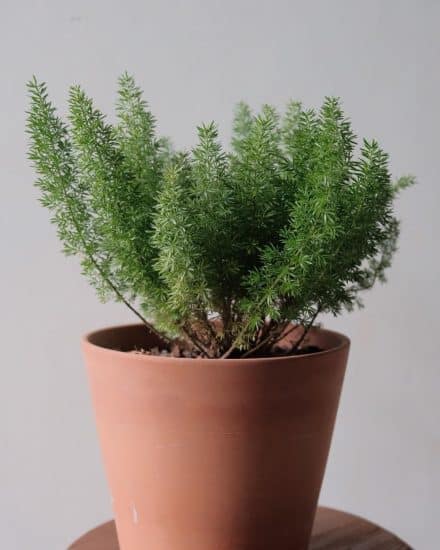
While somewhat drought-tolerant, asparagus ferns will be happiest with moist soil — although they don’t like to be consistently drenched. Watering frequency does go hand in hand with how much light your plant is getting. A plant in lower light will need less water, whereas a plant that gets more consistent bright indirect light will want more.
To avoid overwatering, let the soil become partially dry before giving it a good soak. Bottom watering is a clever way to ensure even moisture throughout the soil.
Insufficient water can make your asparagus fern’s feathery foliage turn dry and shriveled, ultimately leading to leaf drop. If you notice this happening, it’s time to increase the frequency of your watering while still allowing the soil to partially dry before watering again. Really make sure to give it a good soak!
Temperature and humidity
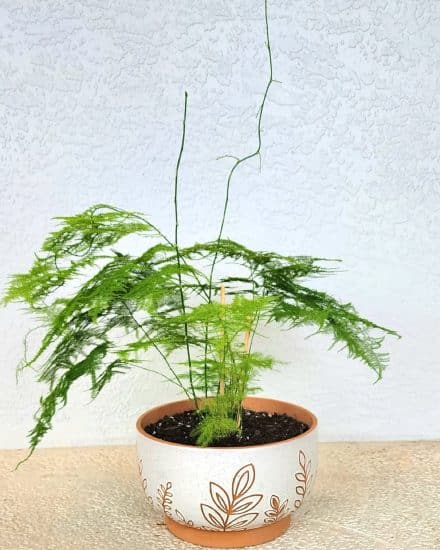
Asparagus ferns thrive in a range of 65-80°F (18-27°C), similar to most houseplants. Be cautious of placing them in areas with drastic temperature fluctuations, as temperatures that are too high or low can stress the plant. Wilting or drooping leaves might be a sign that the temperature isn’t suitable for growing asparagus fern.
As tender plants, asparagus ferns appreciate higher humidity levels and aren’t fans of dry spaces. Aim for 40%-70% humidity. A bathroom with a window would make an ideal spot. Avoid placing them close to heating vents, cold drafts, or air conditioning vents.
If your fern’s fronds become brown and crispy, the humidity is too low. On the other hand, if the plant develops yellow leaves or mold, it might be getting too much humidity.
To maintain a balanced humidity, try using a humidity tray either nearby or under the plant, with pebbles to keep the roots free of standing water. You can also place the plant near a humidifier to give it the extra moisture it craves, especially in dry climates.
Soil and planting
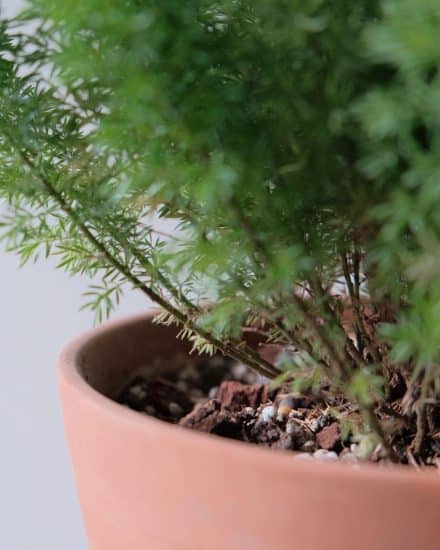
Asparagus ferns thrive in a well-draining potting mix with added perlite for better drainage, so choose a pot with drainage holes. Consider planting your asparagus fern in a hanging basket to let its fern-like stems cascade. If planted outdoors, be sure to keep it in dappled shade and bring it indoors in the winter.
Growing asparagus ferns requires a well-draining potting mix with added perlite for better drainage. The best time to repot your asparagus fern is in early spring, at the start of its growing season.
Fertilizer
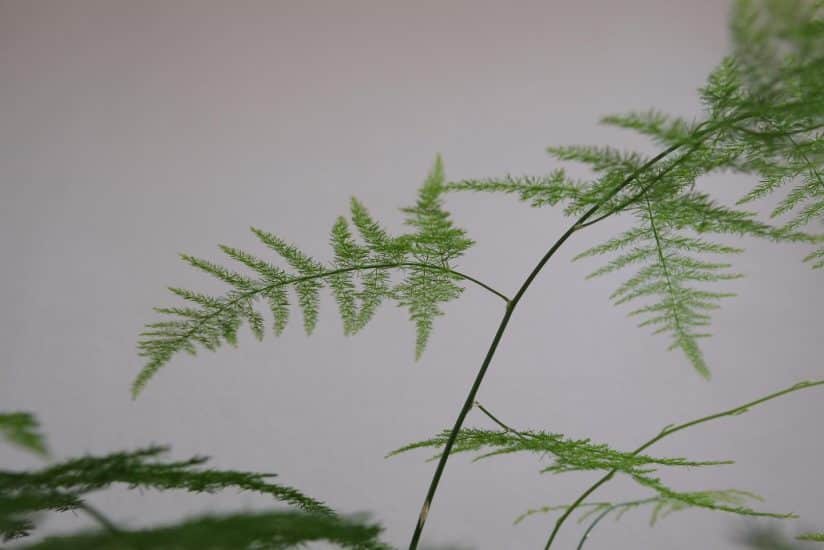
Fertilize once a month from the beginning of spring until early autumn, with a 50% diluted fertilizer.
Over-fertilizing your asparagus fern plant can lead to yellowing leaves, brown tips, and stunted new growth. If you notice these symptoms, it might indicate that you’ve been a little too generous with the fertilizer.
To resolve this issue, stop fertilizing immediately and flush the soil with water to remove excess fertilizer salts. Resume fertilizing at a reduced rate after a couple of weeks, and remember to dilute the fertilizer to half the recommended amount.
Propagation
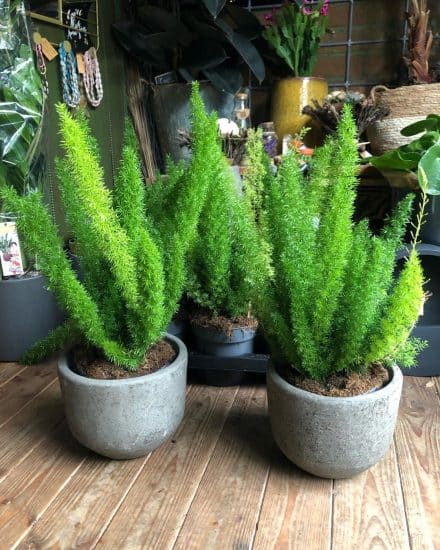
Propagating an asparagus fern plant is not only a fun project, but a fantastic way to share your beautiful indoor plants with friends or multiply your collection. While mature plants do produce seeds and you can propagate that way, the easiest method is through division.
Propagating asparagus fern through division:
- Timing is everything. During the growing season, carefully remove your plant from its pot, and avoid damaging its fragile tuberous roots.
- Next, split the root ball. Use your hands or a clean garden knife to carefully divide the plant into two or more sections, aiming to keep as many roots intact as possible. Make sure each new “baby fern” has enough lace-like foliage to grow happily.
- In small containers with drainage holes and a well-draining potting mix that suits asparagus ferns, nestle each division into place. Top up with potting mix, leaving about an inch of space from the rim for worry-free watering. Give the soil a gentle pat to ensure the roots are nice and comfy.
- Water your newly potted divisions, letting any excess water drain away. Set the asparagus fern babies in a spot with indirect sunlight and keep up with proper humidity levels. Remember to keep the soil moist but not soggy — too much water can cause plant distress.
Common Issues
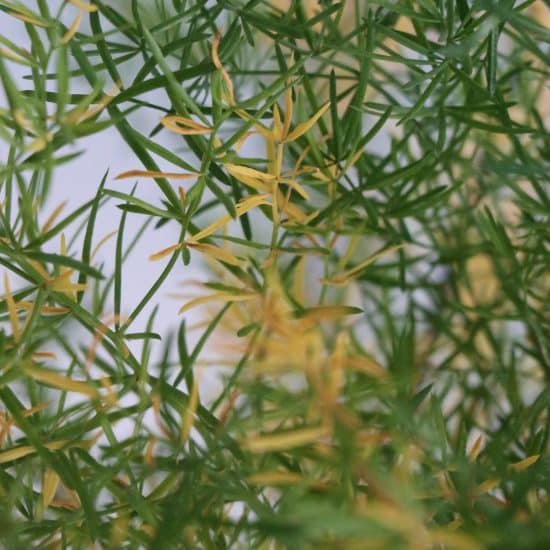
Yellow leaves
An asparagus fern that has turned yellow may be a sign of too little or too much water, or too little or too much light. It could also mean your plant is in need of nutrients. You must analyze your fern’s growing conditions to figure out which cause applies.
If you determine the issue is inadequate light, find a brighter spot for your asparagus fern plant. Likewise, if it’s getting too much sun, move it away from the window a bit.
Overwatering is another culprit that can cause those yellow leaves. Make sure your plant’s pot has a drainage hole and let the soil dry out between waterings (your fern will thank you). If you’ve given your plant too much water, replace only 1/10th of the soil with a fresh layer in the middle of the pot (keeping the same soil at the top and bottom) to avoid disturbing your fern’s fragile roots too much.
If you think your foxtail fern is thirsty, start by increasing the humidity around your plant by installing a humidifier nearby or placing it on a pebble tray.
Dropping leaves
If your asparagus fern is dropping leaves, it’s a sign that it’s unhappy. It could be due to dry indoor air, inconsistent watering, or sudden temperature changes. To increase humidity, place a tray of water nearby or bring out that trusty humidifier.
When it comes to watering, be consistent, and let the top inch of the soil dry out between waterings. Oh, and if you’ve move your fern or if the temperature changes suddenly, try to provide a stable environment with consistent temps (and avoid drafty windows or heating vents) to keep those leaves from dropping.
Pests and diseases
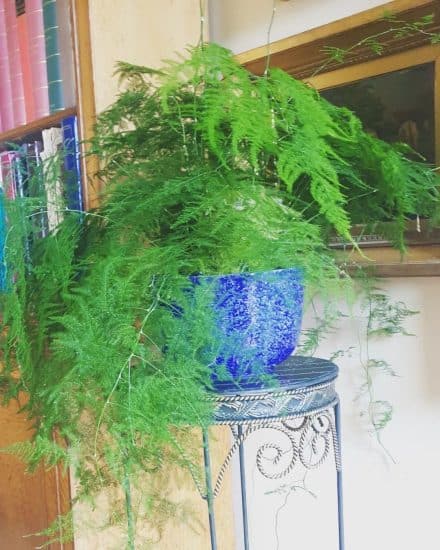
Even though asparagus ferns make amazing indoor houseplants, they’re not immune to some typical indoor plant pests and diseases. We’ll share some practical tips to identify, solve, and prevent them from happening again.
Root rot
Root rot is usually caused by over-watering or poor drainage, transforming the roots into a mushy and unpleasant brown or black mess. You may also observe the fronds turning yellow or wilting.
First, take your asparagus fern out of its pot and be a plant surgeon for a moment. With a sterilized tool, carefully cut away any dark, mushy roots.
Next, give your plant a fresh start by repotting it in well-draining, aerated soil (think perlite, pumice, or LECA). And don’t forget, your pot must have a drainage hole! In the future, water your plant only when the top two inches of soil feel dry.
Pests
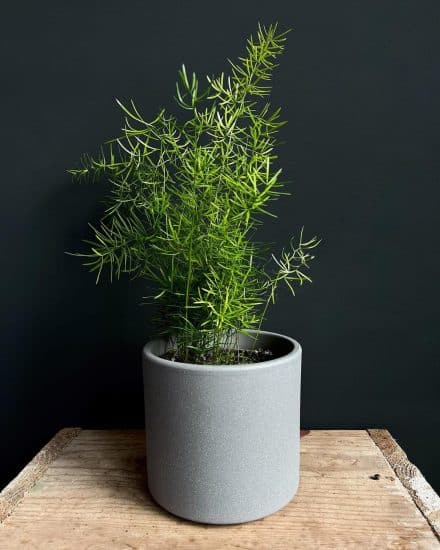
While pests such as aphids, mealybugs, spider mites, or even whiteflies aren’t common with asparagus fern, they’re not unheard of.
To spot aphids or thrips, keep an eye out for small, pear-shaped gangs of insects hanging out on the leaves and stems. Spider mites are trickier to see, but they love leaving behind a telltale sign: fine webbing around the leaves and stems. And mealybugs will look like thin cotton spread over your plant’s leaves and stems.
If you discover these little troublemakers, take action! First, isolate your asparagus fern from other plants so the pests don’t spread. Then, use a damp cloth to carefully wipe down the leaves, removing the pests as you go. For more stubborn infestations, bring out neem oil or a horticultural oil — following the directions on the label, of course.
Conclusion
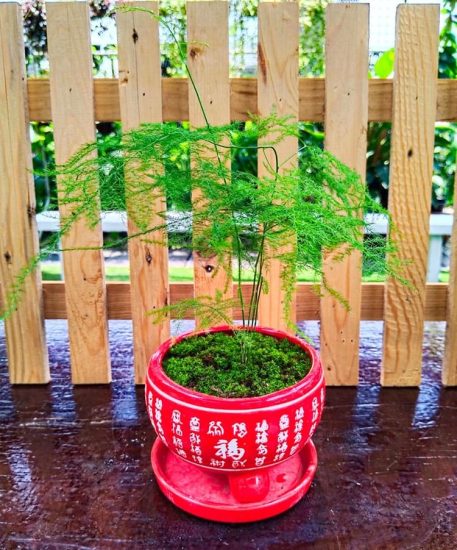
That’s a wrap for our asparagus fern guide! You now have all the knowledge you need to grow asparagus fern at home. From lighting and watering tips to the propagation process, you’re well-prepared to give this lovely plant the care it deserves.
Asparagus fern care summary:
- Provide bright, indirect light to keep your fern happy and healthy.
- Avoid overwatering and maintain consistently moist but not soggy soil.
- Keep in a temperature range of 65-80°F (18-27°C) with humidity levels between 40%-70%.
- Use a well-draining potting mix with added perlite for optimal drainage.
Give it some love, and your asparagus fern will reward you with its delicate and mesmerizing beauty. We hope this guide has been helpful in your journey as a proud asparagus fern owner. If you have any questions, feel free to reach out — we’re always here to help!
Share this guide with your fellow plant lovers and spread the asparagus fern joy.
FAQ
Do asparagus ferns turn into asparagus?
No, unfortunately, asparagus ferns don’t turn into asparagus! While the foxtail fern, or Asparagus densiflorus, shares a resemblance and even belongs to the same botanical family, Asparagaceae, they’re not the same plant as the vegetable we love to munch on.
Why are yellow leaves dropping from my asparagus fern?
Yellow leaves dropping from your asparagus fern is a sign that your green friend may not be getting enough light. To make your fern happy again, move it to a spot with more bright, indirect light. Just remember to avoid harsh, direct sunlight — this can damage delicate foliage.
Does asparagus fern like sun or shade?
Asparagus ferns are moderately light-loving plants, striking a balance between sun and shade. They thrive in bright, indirect sunlight. Think of their natural habitat — they enjoy the dappled shade of a forest canopy.
Is asparagus fern an indoor or outdoor plant?
Asparagus fern can be grown both indoors and outdoors, thanks to its adaptable nature. Just be aware that in some regions, it’s considered an invasive species, so it’s important to grow it responsibly if you choose to keep it outside.
Will asparagus fern survive winter?
Asparagus fern can survive mild winters, but it’s sensitive to extreme cold. If you live in an area with harsh winters, it’s best to keep your fern safely indoors, where you can control its environment. However, if your winters are mild and your outdoor temperatures stay well above freezing, your asparagus fern may be able to tough it out.

